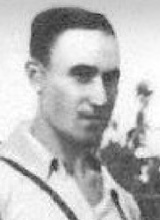Soviet Union

Polkovnik Viktor Vladimirovich Kuznetsov
Soviet Union

Polkovnik Viktor Vladimirovich Kuznetsov

1909 – 12 August 1939
Viktor Kuznetsov was born in 1909.
He graduated from flight school in 1934.
He served as a Zvena CO in 34 IAE of the Kiev Military District.
Leitenant Kuznetsov served as a volunteer in the Spanish Civil War from 7 February 1937.
He served in the 1a/26 flying Polikarpov I-15s.
He was decorated with the Order of the Red Banner on 27 June 1937.
On 1 July, the 1a Escuadrilla was ordered to conduct reconnaissance flights over all of the enemy highway roads coming to Madrid from the west. In the morning, they started the planned flights; however, no results were gained at first.
As the day was tending to the evening, the command decided to conduct the last flight of the day by the whole escuadrilla.
Twelve aircraft took off along a road to Avila. Some 30-40 kilometres from the front line, over the region of Toledo, they met and engaged an equal number of CR.32s.
Leitenant Mikhail Yakushin described the combat:
“I cannot describe the battle in full as this is impossible. 24 aircraft fought over the small space in the sky. All around, grey biplanes with black crosses and green ones with Republican insignia. Burning aircraft and parachutes appeared, but whose? Gradually, ours became all more numerous and only our I-15s remained in the air by the end of this battle. One of them reformed the escuadrilla with signals; this was aircraft of Kapitan Yeremenko which came from the east,...”In all, the escuadrilla claimed six victories without losses, but none of the Soviet pilots could put a claim for four of the shot-down Fiats because of the confusion of the dogfight. In this combat Kapitan Ivan Yeremenko claimed one CR.32 together with Leitenant Kuznetsov (some sources credit them with three shared). Leitenant Yakushin claimed a second, which was confirmed by Yeremenko and Kuznetsov.
The Republican squadrons were effective in defending the airspace above Madrid by day, but the enemy exploited the night to bomb the city. Faced with this situation Starshii Leitenant Anatoly Serov and Leitenant Mikhail Yakushin of the 1a Escuadrilla, both experienced night pilots in their own country, having obtained authorization from the high command, set about organizing a night fighter group comprising of Kuznetsov (CO), Serov, Leonid Rybkin, Yakushin and Vladimir Sorokin. The unit was known as the Patrulla de Noche.
It was no easy task, given that the airfields did not have the necessary infrastructure for night operations (beacons, searchlights, etc). They set up some car headlights and lit bonfires along the runway, which the ground personnel covered over at the first sign of enemy presence, and training began at Alcalá de Henares, whose airfield was the most suitable.
On 6 July, Leytenant Kuznetsov claimed a shared Do 17 together with Leonid Rybkin in the Madrid area.
Kuznetsov left Spain on 7 September 1937. At this time, he had claimed 2 and 3 shared biplane victories.
It seems that in late 1937, he went to China as a volunteer.
The Chinese delegation returned to Stalin on 14 September 1937 with a request for Soviet volunteers. Soon the Komissar of Defense K. E. Voroshilov received an order to assemble the best volunteer aviators and send a squadron of I-16 fighters (31 aircraft and 101 men) and a squadron of SB bombers (31 aircraft and 153 men) to China. At this time a Soviet ‘eskadrilya’ consisted of 31 aircraft in 3 ‘otryady’, each otryad was having 10 aircraft. The remaining aircraft was for the commander. Two or more eskadrilyas equaled a ‘brigada’. During 1938 the ‘eskadrilya‘ was redesignated to ’polk’ (regiment), while the ‘otryad’ was redesignated as an ‘eskadrilya’. The strength or structure did not change, only the names, though later the regiments began to organize with 4 to even 6 component squadrons, while the squadrons themselves became 15 aircraft formations.
A ‘southern’ route was prepared for the bombers. It was planned to send the aircraft in crates to Alma-Ata, assemble them there, and ferry them the rest of the way to China by air. The itinerary, beginning in Alma-Ata, passed through Kuldzhu (Yingying), Shihe, Urumchi, Gucheng (Qitai), Hami, Anxi, Suzhou (Jiuquan), Liangzhou (Wuwei), and concluded in Lanzhou on the Huanghe River. The first commander of the ferry route was the already well-known NII-VVS test pilot Kombrig A. Zalevskii. The base at Alma-Ata was commanded by Kombrig Alekseev. At the series of Chinese aerodromes along the route there were also organized airbases with Soviet ground personnel, including meteorologists, radio operators, and maintenance technicians. At Urumchi the chief of the base was Moiseev, and then A. V. Platonov, at Gucheng - A. V. Politiken, at Suzhou - Glazyrin, at Liangzhou - G. I. Baz’, and at Lanzhou - V. M. Akimov.
For fulfilment of the “special government assignments” the selected voluntary Soviet fighter and bomber pilots assembled from across the country in conditions of the strictest secrecy from the middle of September and through the first ten days of October (‘Operation Zet (Z)’). Many of those who were chosen at first believed that they were headed for “the Spanish corrida”, but their long road led to “the Sino-Japanese tea ceremony”.
Fighter pilots sent from all districts for the Far Eastern special aviation units were inspected by the “Spaniards” Kombrigs Ya. V. Smushkevich and Petr Pumpur. Many veterans from the 9 OIAE (Independent Fighter Squadron) were chosen but also some fresh pilots, including Dimitriy Kudymov, Korestelev, Bredikhin and Kuznetsov. From the 32 OIAE of the Pacific Ocean Fleet six were chosen, among them Aleksey Dushin, S. Remizov and Manuilov. In the command staff of the air group several test pilots were included; among these was A. N. Chernoburov.
Airmen for the bombers were selected mainly from units of the 1st Army of Special Designation. From there arrived 22 SB crews, five for the TB-3s and seven for the DB-3s. The last aircraft type, having just appeared as the “super-new” aircraft in Soviet bomber aviation, had not been gathered to hand over to the Chinese. At first they were to be used as fast transports for servicing the ferry route itself. Each DB-3 could carry 11 passengers or equivalent cargo. Transport TB-3s and the old civil ANT-9 were also used alongside them on the route in the beginning to transport specialists and cargo.
He was decorated with the Order of Lenin on 14 November 1938.
As a Polkovnik he went to Mongolia in August 1939 to take part in the Nomonhan Incident with Japan as CO of 22 IAP but was killed in a plane crash on 12 August.
He was buried in the area of height 701.
At the time of his death, Kuznetzov was credited with 2 biplane victories. All of them claimed in Spain.
Claims:
| Kill no. | Date | Time | Number | Type | Result | Plane type | Serial no. | Locality | Unit |
| 1937 | |||||||||
| 01/07/37 (a) | evening | 1/2 (b) | CR.32 | Shared destroyed | I-15 | Toledo | 1a/26 | ||
| 06/07/37 | 1/2 | Do 17 | Shared destroyed | I-15 | Madrid area | 1a/26 | |||
| 1 | ??/??/37 | 1 | He 51 | Destroyed | I-15 | 1a/26 | |||
| 2 | ??/??/37 | 1 | He 51 | Destroyed | I-15 | 1a/26 | |||
| ??/??/37 | 1/? | He 51 | Shared destroyed | I-15 | 1a/26 |
Biplane victories: 2 and 3 shared destroyed.
TOTAL: 2 and 3 shared destroyed.
(a) Some sources states that the date was 30 June 1937.
(b) Some sources credits him with three shared in this combat.
Sources:
Air War over Spain - Jesus Salas Larrazabal, 1974 Ian Allan Ltd, Shepperton, Surrey, ISBN 0-7110-0521-4
Polikarpov I-15, I-16 and I-153 Aces - Mikhail Maslov, 2010 Osprey Publishing, Oxford, ISBN 978-1-84603-981-2
Soviet airmen in the Spanish civil war 1936-1939 - Paul Whelan, 2014 Schiffer Publishing Ltd, ISBN 978-0-7643-0
Soviet Fighter Pilots 1936-1953 - Mikhail Bykov
Additional information kindly provided by Alfredo Logoluso.


